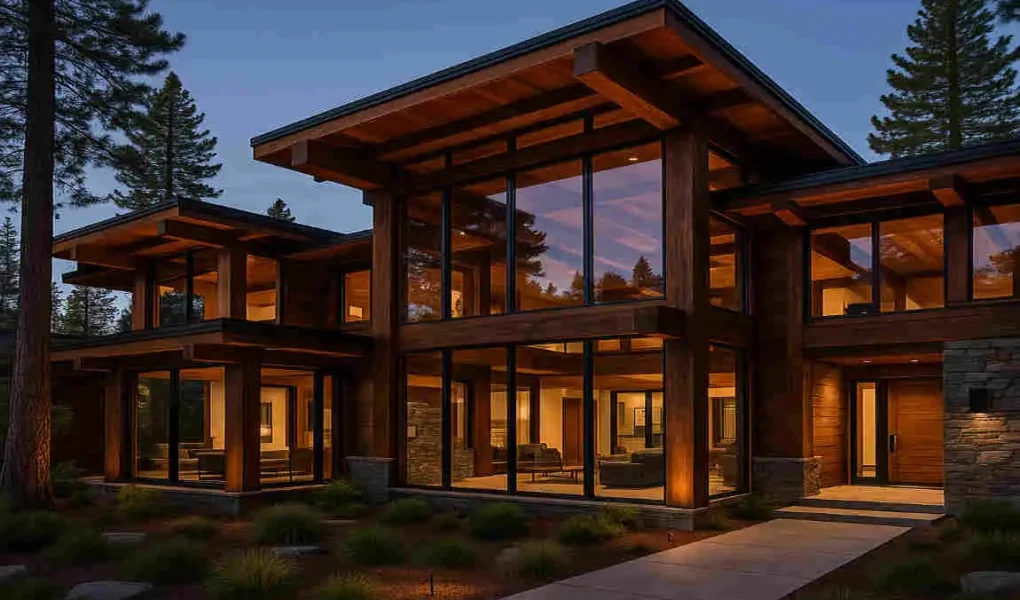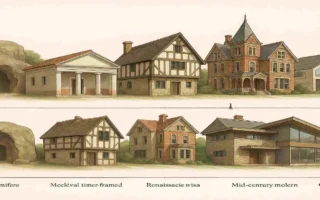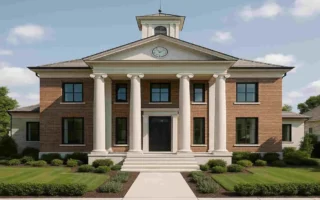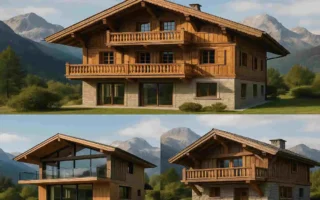Have you ever dreamed of living in a modern home that feels both timeless and cutting-edge? Picture a space where massive wooden beams soar overhead, blending the raw beauty of nature with sleek, modern touches. That’s the magic of a modern bigwood house. In today’s fast-paced world, more people are turning to these innovative structures to revamp their living spaces. They’re not just houses; they’re statements of style, sustainability, and creative design.
Why does this matter? Well, our homes shape how we live, work, and relax. With climate change on everyone’s mind and a push for eco-friendly living, transforming your space with a modern bigwood house offers a fresh way to connect with the environment without sacrificing comfort or flair. These homes draw on age-old building techniques but elevate them with contemporary twists, making them perfect for anyone craving a unique abode.
Understanding Modern Bigwood Houses
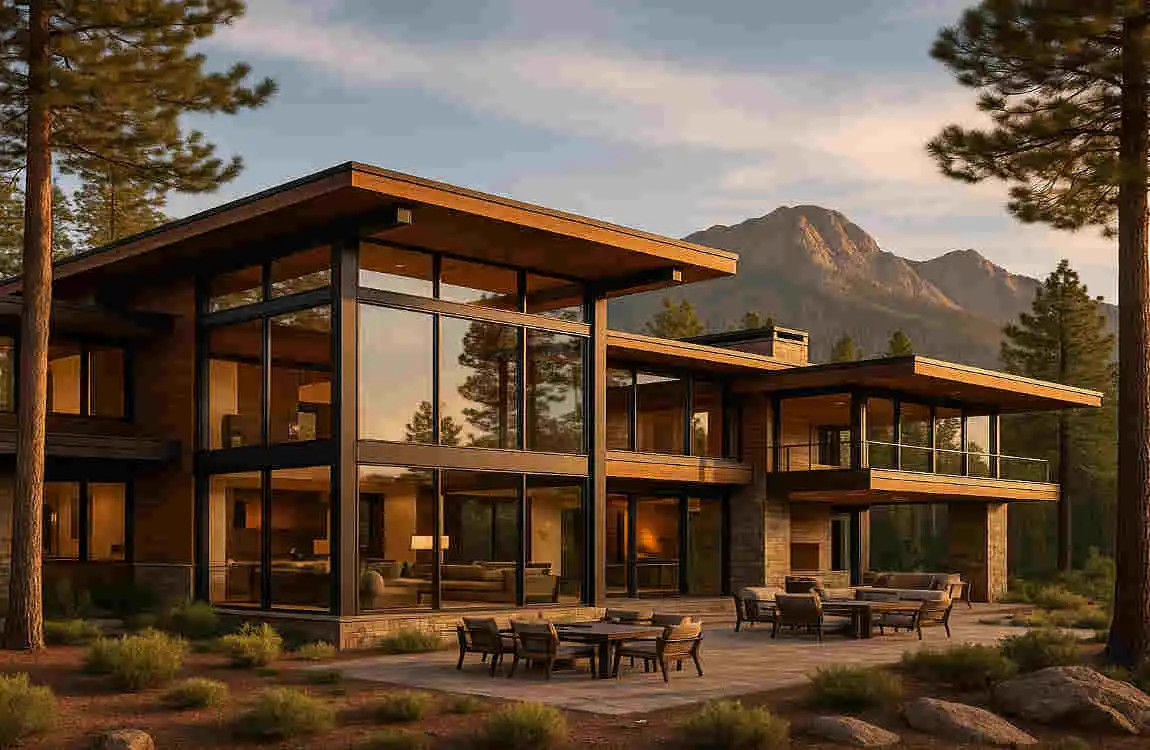
What Exactly Is a Bigwood House?
Let’s start by demystifying the term. A modern bigwood house isn’t just any wooden structure—it’s a home defined by its use of significant, exposed timber elements. Think hefty beams and posts that form the backbone of the building, often visible inside and out. The “bigwood” part comes from these oversized wooden components, which give the house its sturdy, grounded feel.
In simpler terms, it’s like building with giant logs or planks, but refined for today’s tastes. Unlike flimsy stick-frame houses, a bigwood home relies on substantial wood pieces to hold everything together. This creates open, airy spaces that feel expansive and inviting. If you’ve ever walked into a cabin with towering wooden supports, you’ve got the idea—but modern versions take it to the next level with clean lines and tech-savvy features.
A Quick Look at Their History and Evolution
Bigwood houses have roots that stretch back centuries. Early settlers in places like Scandinavia and North America used massive timbers to construct durable shelters that protected them against harsh weather conditions. These weren’t fancy; they were practical, using whatever trees were nearby to create homes that lasted generations.
Fast forward to today, and the modern bigwood house has evolved dramatically. Architects now blend those traditional methods with cutting-edge design. Thanks to advancements in engineering, we can build taller, more intricate structures without losing that natural vibe. Globalization has also played a role—wood from sustainable forests around the world makes these homes accessible everywhere. It’s fascinating how something so old-school has become a hot trend in contemporary architecture.
Key Features That Define a Modern Bigwood House
What sets a modern bigwood house apart? For starters, those large timber beams aren’t hidden—they’re the stars of the show. They create open layouts where rooms flow seamlessly, perfect for family gatherings or quiet evenings.
Natural finishes are another hallmark. Woods like oak or pine get treated to highlight their grains, adding warmth without overwhelming the space. Modern twists include floor-to-ceiling windows that flood the interior with natural light, seamlessly merging the indoor and outdoor worlds. Energy-efficient elements, like insulated walls, keep things cozy year-round.
How They Compare to Traditional Wooden Houses and Other Builds
Compare this to a traditional log cabin, which might feel rustic and enclosed. A modern bigwood house opens things up with minimalist aesthetics—no clutter, just clean elegance. Against brick or concrete homes, Bigwood stands out for its organic appeal and lower environmental impact.
Steel-frame buildings might win on speed, but they lack the soul of wood. Bigwood offers a middle ground: strong like metal, beautiful like nature. Globally, people love them for blending seamlessly with landscapes, from mountain retreats to urban lofts.
Why Are They Gaining Popularity Worldwide?
The surge in popularity boils down to a few big reasons. In a world obsessed with sustainability, modern bigwood houses use renewable resources, appealing to eco-conscious folks. They’re also versatile—fit for city apartments or countryside estates.
Social media plays a part, too. Scroll through Instagram, and you’ll see stunning examples that inspire homeowners everywhere. Plus, with rising construction costs, Bigwood’s efficiency makes it a wise choice. If you’re thinking about your next home project, consider how a modern bigwood house could fit into your life. It’s more than a trend; it’s a lifestyle shift toward harmony with nature.
Benefits of Choosing a Modern Bigwood House
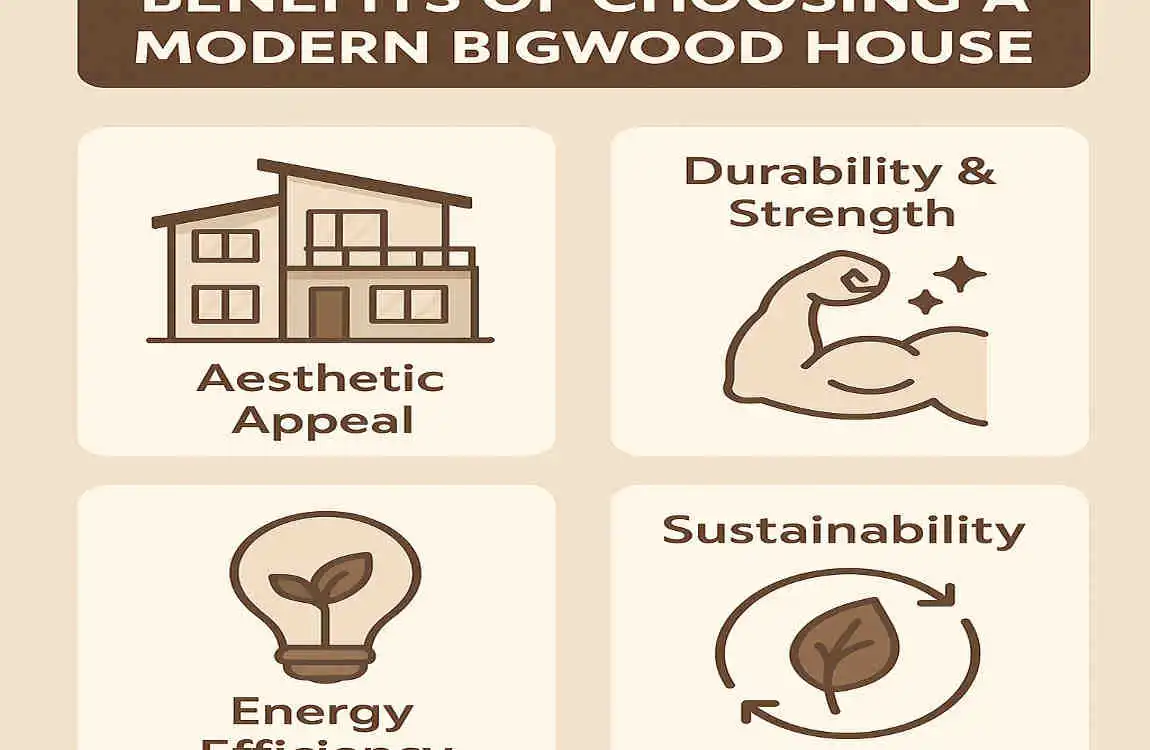
Eco-Friendliness and Sustainability at the Core
One of the biggest draws of a modern bigwood house is its green credentials. Wood is a renewable resource, meaning we can grow more trees to replace what’s used. This reduces the carbon footprint compared to materials like concrete or steel, which require significant energy to produce.
Think about it: trees absorb carbon dioxide as they grow, so building with wood actually locks away that carbon for decades. In a modern bigwood house, you’re not just living sustainably—you’re actively helping the planet. If you’re someone who cares about the environment, this benefit alone might sway you.
The Warm, Inviting Aesthetic Appeal
Wood brings a unique charm that’s hard to beat. In a modern bigwood house, those exposed beams and natural textures add warmth and character. It’s like wrapping your home in a cozy blanket, but with a stylish twist.
Unlike cold, sterile modern designs, Bigwood infuses personality. The grains and knots in the wood tell a story, making each house one-of-a-kind. Imagine curling up by a fireplace with that woody aroma—it’s an aesthetic that feels both timeless and fresh. Doesn’t that sound like the perfect backdrop for your daily life?
Superior Thermal Insulation and Energy Savings
Here’s where things get practical. Wood naturally insulates, keeping your home warm in winter and cool in summer. A modern bigwood house often incorporates advanced insulation techniques, slashing your energy bills.
This efficiency comes from the wood’s cellular structure, which traps air and resists temperature changes. Pair it with bright windows and seals, and you’ve got a home that’s easy on the wallet and the grid. Have you checked your utility bills lately? Switching to Bigwood could make a real difference.
Unmatched Structural Strength and Longevity
Don’t let the natural look fool you—these houses are built to last. Bigwood construction uses thick timbers that withstand earthquakes, high winds, and heavy snow better than many alternatives.
Over time, wood ages gracefully, developing a patina that enhances its beauty. With proper care, a modern bigwood house can stand firm for centuries. It’s durable, resilient, and ready for whatever life throws at it. Why settle for something flimsy when you can have strength wrapped in style?
Health Perks from Natural Materials
Living in a modern big house can also boost your well-being. Wood doesn’t off-gas harmful chemicals like some synthetic materials do, resulting in improved indoor air quality.
Studies show that natural environments reduce stress and improve mood. Surrounded by wood, you feel more relaxed and connected to nature. Plus, it’s hypoallergenic for many people. If health is a priority, Bigwood offers benefits that go beyond the obvious.
Design Versatility and Customization Options
Finally, let’s talk flexibility. A modern bigwood house adapts to your vision, whether you want a sleek minimalist pad or a rustic retreat. Customize layouts, finishes, and features to suit your needs.
This versatility extends to additions like home offices or outdoor decks. You’re not locked into a cookie-cutter design—Bigwood lets your creativity shine. Ready to make your space truly yours?
Here’s a quick list of key benefits to keep in mind:
- Sustainability: Renewable and low-carbon.
- Aesthetics: Warm, unique character.
- Efficiency: Excellent insulation for energy savings.
- Durability: Strong against elements.
- Health: Better air quality and stress relief.
- Versatility: Endless customization.
Design Elements of Modern Bigwood Houses

Exploring Architectural Styles That Shine with Bigwood
When it comes to modern bigwood house design, variety is the spice of life. Scandinavian styles lead the pack, with their clean lines and emphasis on functionality. Picture slim beams framing vast windows, letting light dance across wooden floors—it’s simple yet stunning.
Rustic modern takes a cozier approach, mixing rough-hewn timbers with plush fabrics. Minimalism strips it down, using bigwood as the focal point without extras. Each style transforms the space, making your home a reflection of your unique personality. Which one speaks to your taste?
Interior Concepts: Blending Beams with Modern Furnishings
Inside a modern bigwood house, design magic happens when you pair those massive beams with contemporary pieces. Think leather sofas against exposed wood walls, or metal accents that contrast the warmth.
Open shelving from reclaimed timber adds storage without clutter. Layer in textures like wool rugs or linen curtains to soften the edges. It’s all about balance—let the wood shine while modern elements keep it fresh. Imagine hosting friends in a space that feels both grand and intimate.
Maximizing Open Floor Plans and Natural Light
Open layouts are a hallmark of bigwood house architecture. Without walls dividing rooms, spaces flow freely, ideal for families or entertainers. Bigwood beams support this openness, creating high ceilings that make rooms feel larger.
Natural light amplifies the effect. Strategically placed skylights or glass walls flood the interior, highlighting wood grains and reducing the need for artificial lighting. This design not only saves energy but also connects you to the outdoors. How would more light change your daily routine?
Finishing Techniques That Enhance Bigwood Beauty
Finishing your bigwood isn’t just about protection—it’s an art. Oiling brings out the natural luster, while staining adds subtle color without hiding the texture. Natural polishes keep things eco-friendly and easy to maintain.
For a modern twist, try matte finishes that downplay shine for a subtle vibe. These techniques preserve the wood’s integrity while allowing you to personalize it. Experimenting with finishes can totally transform a room’s mood.
Integrating Other Natural Materials for Depth
Don’t stop at wood—blend in stone, glass, and metal for a richer design. Stone fireplaces ground the space, glass panels invite views, and metal fixtures add an industrial edge.
This mix creates harmony, making your contemporary bigwood home feel layered and lived-in. It’s like composing a symphony where each material plays its part. Ready to mix and match in your own project?
Tips for Merging Tradition and Innovation
Blending old and new starts with respect for the wood’s heritage. Utilize traditional joinery techniques while incorporating innovative technology, such as automated lighting.
Innovate by adding eco-features, such as solar panels on a timber roof. Keep scale in mind—bigwood thrives in balanced proportions. These tips ensure your design feels authentic yet forward-thinking.
Inspirational Examples of Bigwood Interiors and Exteriors
Let’s get inspired! Consider a Norwegian cabin with soaring beams and minimalist decor—pure serenity. Or a California home where bigwood meets ocean views through expansive glass.
Exteriors often feature weathered wood siding that blends seamlessly with its natural surroundings, evoking a sense of a forest retreat. Inside, think lofts with exposed rafters overlooking living areas. These examples show the endless possibilities. Which one sparks ideas for your space?
To visualize better, here’s a simple table comparing design elements:
Element Traditional Bigwood Modern Bigwood
Beams : Hidden or rustic, Exposed and sleek
Lighting : Minimal, artificial, Abundant natural
Materials Mix : Mostly wood , Wood + glass/metal
Layout : Closed rooms , Open and flowing
Materials and Construction Techniques
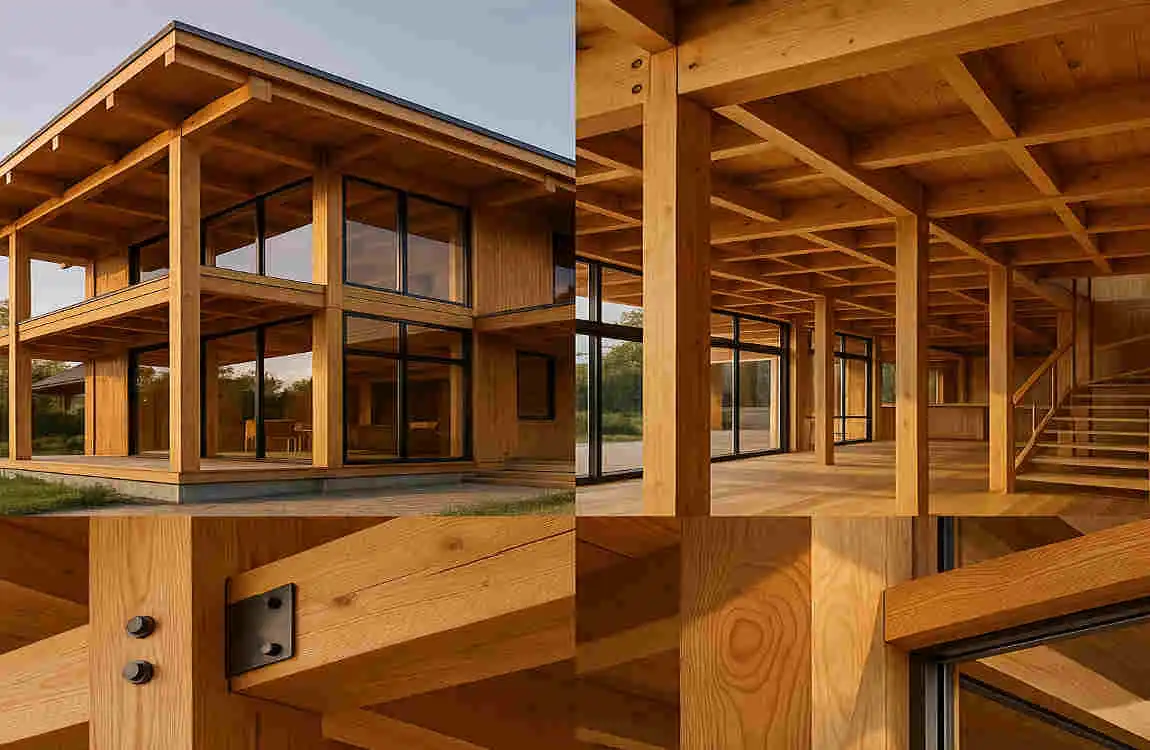
Common Types of Wood in Bigwood Architecture
Choosing the right wood is key to your modern bigwood house. Oak stands out for its strength and rich grain, perfect for beams that endure. Cedar resists rot and insects, making it ideal for exterior use.
Pine offers affordability and a light color, while Douglas fir provides density for structural support. Each type brings unique qualities—pick based on your climate and style. Ever wondered which wood would suit your dream home?
Sourcing Sustainable and High-Quality Timber
Sustainability isn’t optional—it’s essential. Look for certifications like FSC, ensuring wood comes from responsibly managed forests. This supports the environment and guarantees quality.
High-quality timber means fewer defects, leading to a sturdier house build. Work with suppliers who prioritize ethical sourcing. By choosing wisely, you’re investing in a home that’s good for the planet and built to last.
Modern Methods: Timber Frame and Post-and-Beam
Construction in a modern bigwood house often uses timber frame techniques, where large wooden skeletons are assembled on-site. Post-and-beam is similar, with vertical posts supporting horizontal beams for open spaces.
These methods allow for precision and speed. They’re flexible too, accommodating custom designs. If you’re building, these approaches make the process smoother and more efficient.
Tackling Challenges Like Maintenance and Weatherproofing
Wood faces hurdles like moisture and pests, but solutions abound. Regular sealing protects against the weather, while treatments ward off insects.
Maintenance involves inspections and touch-ups—nothing too daunting. Innovations like pressure-treated wood solve many issues upfront. With the proper care, your bigwood house stays beautiful for years.
Innovations Bringing Bigwood into the Future
Enter prefabrication: factories build components off-site for quick assembly, reducing waste. Engineered wood products, like glulam beams, offer strength without harvesting old-growth trees.
These advancements make bigwood construction techniques more accessible and eco-friendly. They’re changing how we build, one innovative beam at a time.
Transforming Your Space with a Modern Bigwood House: Practical Tips

Assessing If Bigwood Is Right for Your Space
Start by evaluating your needs. Does your lifestyle crave open, natural vibes? A modern bigwood house shines in spacious lots but adapts to urban spots too.
Consider your location—wood works in most climates with proper prep. Ask yourself: How can Bigwood enhance my daily life? This step ensures a perfect fit.
Renovation vs. New Build: What to Weigh
Renovating an existing home with bigwood elements, such as adding exposed beams, is both cost-effective and quick. New construction offers full customization but takes more time and money.
Weigh the pros of personalization against the cons of disruption. For many, a hybrid approach works best—renovate smartly to transform your space.
Finding Experts in Modern Bigwood Houses
Hunt for architects and builders with bigwood experience. Check portfolios and reviews—specialists understand the nuances.
Network through design shows or online forums. The right team turns your vision into reality. Don’t settle; find pros who get your style.
Budgeting and Financing Your Project
Plan your budget early, factoring in materials, labor, and surprises. Financing options include home loans or green incentives for sustainable builds.
Break it down: Allocate for essentials first. With thoughtful planning, a modern big wood house renovation remains affordable.
Adding Bigwood Touches in Small Ways
Not ready for a complete overhaul? Start small with accent walls or beams in key rooms. These add character without significant commitment.
It’s an easy way to test the waters and gradually transform your space. You’ll love the instant warmth.
Maintenance Tips for Longevity
Keep your bigwood looking sharp with annual cleanings and seals. Watch for moisture and treat promptly.
Simple habits, such as using coasters and avoiding direct sunlight, help preserve the finish. Your home will thank you with years of beauty.
Trends and Innovations in Modern Bigwood Houses
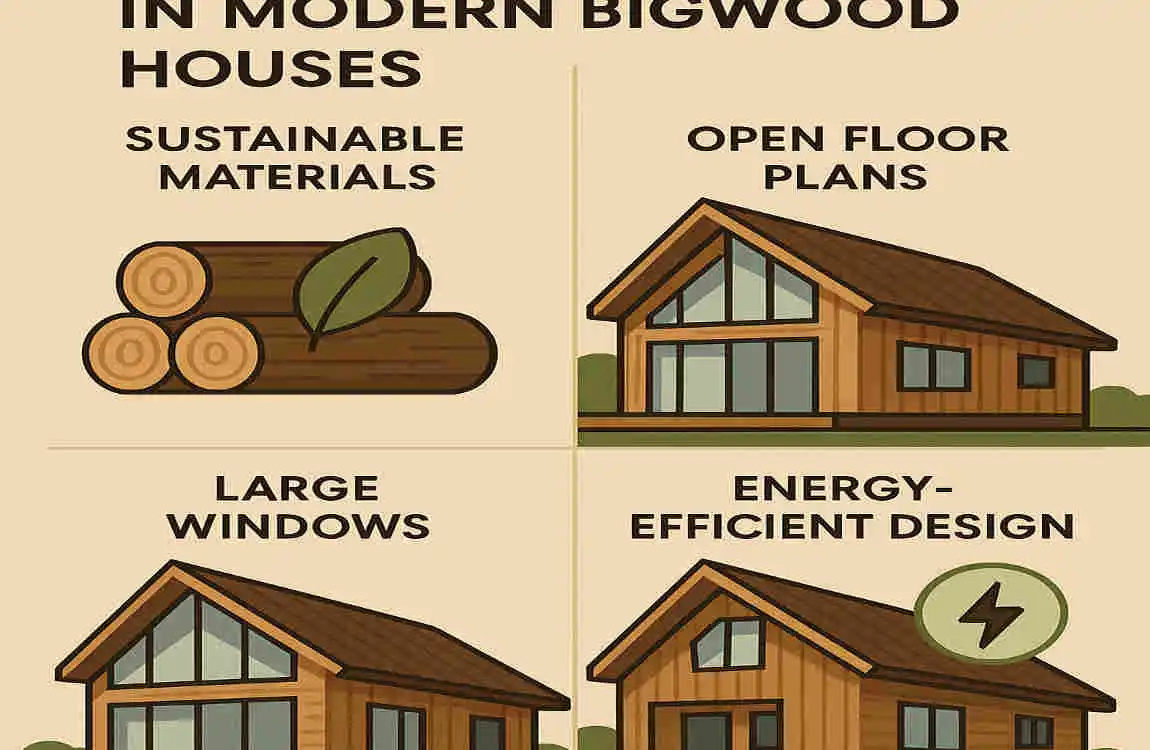
Smart Home Tech Meets Bigwood Charm
The future of modern bigwood house trends includes seamless smart integration. Voice-controlled lights and energy systems blend into wooden frames without clashing.
Imagine adjusting your thermostat from your phone while enjoying the natural ambiance. This fusion keeps homes efficient and connected.
The Rise of Tiny Bigwood Houses and Cabins
Tiny homes are booming, and Bigwood house fits perfectly. Compact cabins utilize efficient designs for off-grid living, appealing to minimalist enthusiasts.
They’re affordable and eco-friendly, ideal for vacations or downsizing. Have you considered a tiny retreat?
Reclaimed Wood and Eco-Innovations
Using salvaged wood reduces waste and adds history. Innovations like bio-based treatments enhance durability without relying on chemicals.
This trend pushes sustainability further, making Bigwood even greener.
Modular and Prefab Designs for Speed
Prefab bigwood modules assemble like puzzle pieces, cutting build time. They’re customizable and transportable.
This innovation democratizes bigwood, making it accessible to more people.
Looking Ahead: The Future of Bigwood Housing
Expect more hybrid materials and AI-designed layouts. As sustainability grows, the future of Bigwood Homes will lead in eco-architecture.
It’s an exciting time—Bigwood is evolving to meet tomorrow’s needs.
Frequently Asked Questions about the Modern Bigwood House
Q: Where is the Bigwood Residence located? A: The Bigwood Residence is tucked into a hillside in Sun Valley, Idaho, USA .
Q: What is the size of the Bigwood Residence? A: The Bigwood Residence measures 6,500 square feet (604 square meters) .
Q: When was the Bigwood Residence designed? A: The Bigwood Residence was designed by Olson Kundig in 2017 .
Q: What are some unique features of the Bigwood Residence? A: The Bigwood Residence features a 23-foot-wide (7-meter-wide) pivot door on a steel and glass bridge that allows the entire south-facing wall to open, transforming the bridge into an outdoor space . The house also has a fourteen-foot-long dining room table made of salvaged black walnut on a steel frame with oversized rollers, designed to divide into two and roll onto the adjoining deck . Additionally, the master bath features an indoor/outdoor stone shower with Montana moss rock .
Q: What materials are used in the Bigwood Residence? A: The Bigwood Residence features earthy materials and a neutral color palette, with walls, ceilings, and floors sheathed in wood, lending a sense of warmth to the space . The house also incorporates salvaged black walnut, steel frames, and oversized rollers .

